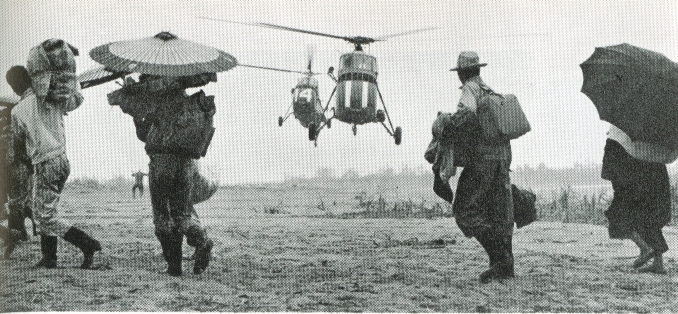

My first disaster rescue experience occurred during the six days of September 30 through October 5, 1959 in Nagoya, Japan.
At that time the Ise-wan typhoon had just devastated the city of Nagoya, and the U.S.S. Kearsarge (CVS 33), enroute to Yokosuka, was diverted to rescue the many people who were stranded on small and scattered pockets of land. As one of several helicopter crewmen assigned to Helicopter Anti-Submarine Squadron Six (HS-6), we flew numerous rescue flights to tiny pockets of land amid a vast "sea of water," over what was once land and homes, to remove countless people to safety. Above is a picture of two of our helicopters preparing to land on one of the few pieces of land where thousands huddled in the cold awaiting rescue. The picture on the right show the total devastation associated with the typhoon and the high tide. As our large carrier was pulling into that port, we shut off our water intake because of the many dead bodies and other material floating everywhere. That and others sights and smells created lasting impressions.
From early morning until dark, we picked up people stranded on large and small plots of land. And we returned to the Kearsarge only to refuel, which was more often than usual because of the heavy loads associated with the full cabins of bewildered people, most of whom did not speak any English.
The pictures on this page were taken during that rescue operation in 1959. Click on any of the smaller thumbnail pictures to view a larger image of that picture.
Women with babies were given priority, yet it was difficult to keep families together. Day after day we made numerous flights through dozens of tall pillars of thick black stench from the fires being used to burn the dead in an effort to prevent the spread of disease. This event stands out as one of Japan's worst disasters with more than 4,700 people reported dead.
When we returned to Nagoya on February 18, 1960, the U.S. -- Japanese relations were never higher.
- USS Kearsarge
- Official HS-6 insignia
- Looks like Charles O. Borgstrom, then a LT and one of my favorite officers, made Captain and C.O.
My second rescue effort occurred that same cruise. My official Letter of Commendation states, "While at anchor in Buckner Bay, Okinawa, on 26 January, 1960, this vessel was notified that a whaleboat from the USS Midway (CVA 41) was overdue from a fishing trip and helicopter assistance was needed. You immediately maned a helicopter and commenced a search for the whaleboat and its personnel. You located two search boats aground on a coral reef about four miles south of the USS Midway. You then rescued a total of seven enlisted personnel and two officers from the grounded boats and returned them to Kearsarge in safety. This necessitated a total of three round trips between the boats and Kearsarge. These rescue operations were conducted under conditions of darkness, gusty winds of 20 to 25 knots, and intermittent light rain. Visibility was reduced to one mile in some areas. Your undivided attention and devotion to duty were in keeping with the highest traditions of the United States Naval Service and you are hereby commended for your outstanding performance of duty. This letter will be made a part of your official record."
[signed] R. L. Townsand, Commanding Officer and dated 20 February 1960.
On October 7, 1960 the pilots and crewmembers received letters of commendation from the Secretary of the Navy, W. B. Franke.
That cruise was distinguished for its rescues as noted here.